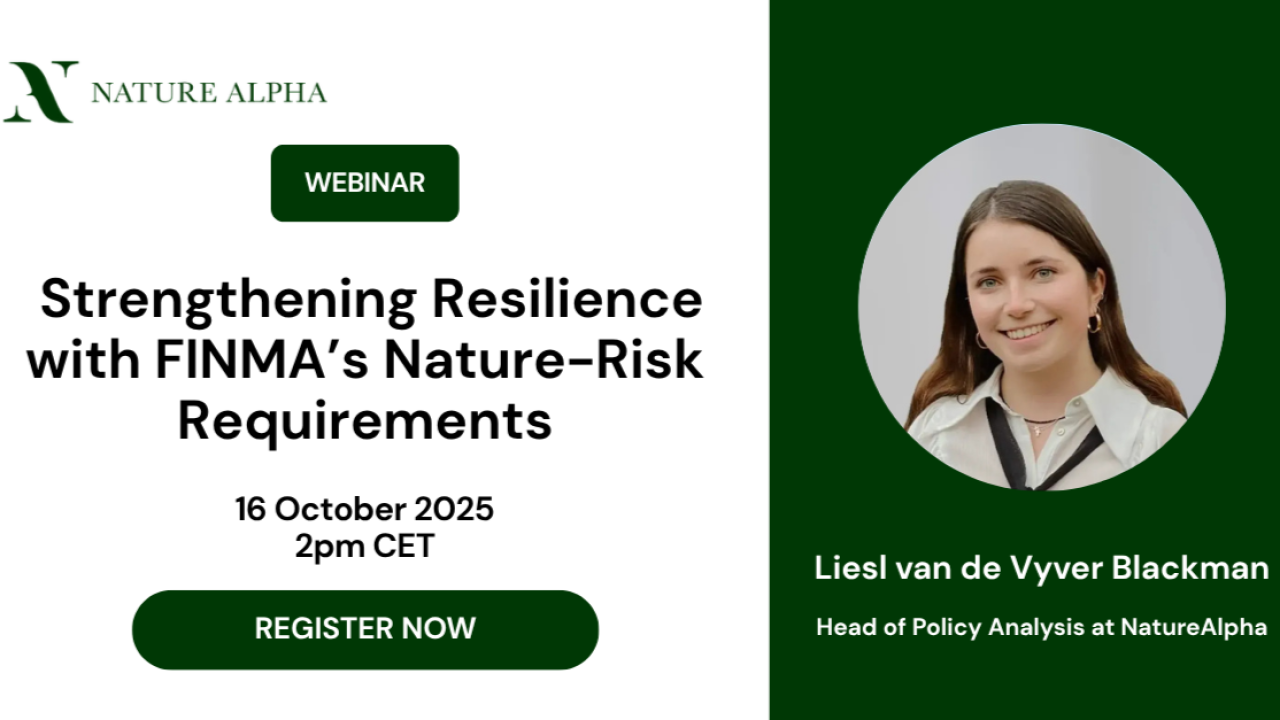Choosing a Nature and Biodiversity Data Provider: A Practical Guide for Financial Institutions

Biodiversity and nature-related risk have moved from the scientific margins to the centre of financial debate. For many investors, the question is no longer if nature will become financially material, but how soon.
With frameworks like TNFD gaining traction and regulations like CSRD and FINMA moving toward en forcement, asset owners and managers are under increasing pressure to quantify nature impacts, dependencies, and exposures. Yet the data landscape remains complex, fragmented, and—frankly—overwhelming.
If you're trying to make sense of it all, this guide is for you. We've put together a checklist to help sustainability teams, risk officers, and portfolio managers evaluate nature and biodiversity data solutions that are robust, actionable, and future-proof.
1. Does the Provider Understand the Needs of Finance?
Not all biodiversity tools are built for institutional investors. Look for solutions that deliver:
- Asset-level granularity, including coverage across public and private markets
- ISIN-level traceability for integration with portfolio management systems
- Outputs tailored to use cases such as fundamental due diligence, screening, stewardship, and regulatory disclosure
Many tools were designed for corporate sustainability teams or academic modelling. Make sure your provider can speak the language of risk, return, and regulatory alignment.
2. Is the Methodology Scientifically Grounded and Transparent?
Nature-related finance is still an emerging discipline, and credibility matters.
An effective provider should:
- Use peer-reviewed science and a clearly documented methodology
- Align with leading frameworks such as TNFD, ISSB and ESRS
- Provide traceable sourcing of data and logic, so outputs can be audited or challenged if necessary
Watch out for "black box" ratings or overly simplified nature scores that don't hold up under scrutiny.
3. Can the Platform Handle Spatial Complexity?
Nature is inherently geospatial. The physical location of assets—relative to forests, wetlands, protected areas, or biodiversity hotspots—matters immensely.
When evaluating platforms, consider:
- Does it offer asset geolocation down to parcel level?
- Can it evaluate proximity risks to sensitive ecosystems or deforestation fronts?
- Does it support visual analysis for spatial exposure across a portfolio?
This becomes particularly important when assessing tail risks or transition risk under new regulatory regimes.
4. How Usable Is the Data Across the Organisation?
For many sustainability teams, the challenge isn’t just access to nature data—it’s making it usable for colleagues across investment, risk, compliance, and stewardship.
Look for a provider that offers:
- Multiple delivery formats (e.g. API, Snowflake, machine-readable outputs)
- A user-friendly interface for ESG analysts and portfolio managers
- The ability to support disclosure, internal analysis, and client communication from a single source
Flexibility is essential, especially for teams already managing climate disclosures under tight resource constraints.
5. Is There True Asset Class Coverage?
Most portfolios are multi-asset. A nature platform that covers only equities—or lacks precision for private markets—won’t cut it.
Consider:
- Does it cover corporate bonds, private equity, real assets, and listed equities?
- Can it support cross-asset comparisons and portfolio-level biodiversity metrics?
- Are metrics consistent across asset classes?
This is especially important for managers looking to align multiple funds with nature-positive goals or run firm-wide TNFD pilots.
6. Is the Provider Set Up for Regulatory Change?
The regulatory environment is evolving quickly. Platforms should be capable of adapting as TNFD, CSRD, article 29 (France), FINMA (Switzerland) and other frameworks mature and move toward enforcement.
Checklist:
- Does it provide reporting outputs that are machine-readable and aligned with evolving requirements?
- Can it support double materiality assessments and LEAP analyses?
- Is the underlying data model flexible enough to evolve with scientific and policy changes?
Future-proofing isn’t a luxury—it’s a necessity.
7. Can the Tool Drive Real Outcomes?
Finally, nature risk data isn’t just about compliance. The best tools can also help you:
- Identify new engagement opportunities for stewardship teams
- Optimise portfolios by reducing exposure to nature-related risks
- Generate credible impact narratives for clients and marketing
- Respond to custom data requests from asset owners or consultants
If the tool doesn’t unlock action, it’s probably not the right one.
Final Thoughts
Choosing a biodiversity and nature risk provider isn’t about finding a perfect dataset—it’s about partnering with a platform that can evolve with your needs, support multiple use cases, and build trust across your organisation.
As this space matures, the leaders won’t be those with the loudest dashboards or most colourful risk scores. They’ll be the ones who can:
- Translate nature into decision-grade insight
- Align with financial workflows
- Ground their outputs in real science
Because at the end of the day, biodiversity isn’t just a box to tick—it’s a systemic risk and a strategic opportunity.
.png)










.jpg)
.jpg)